Why the army was interested in camels is a story in itself. Most historians attribute the camel idea, or at least the original one, to George H. Crosman who served with the army in the Seminole Wars in Florida.
Thank you for reading this post, don't forget to subscribe!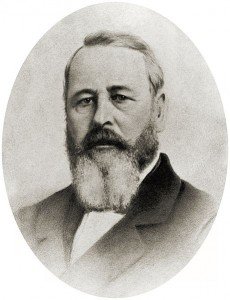
The Camel Idea?
Starting in the 1830’s Crosman promoted the use of camels to the federal government but not with much success. The American frontier in the 1840’s ran basically on a line from Minnesota down through Missouri and then through Arkansas and east Texas.
The arid regions of the desert southwest were outside the American domain and were explored and governed by Spain. When Spain was expelled in the 1820’s the region was ruled by Mexico. Because the U.S. frontier at that time was far from the desert southwest, the camel, which was associated with the desert regions of the Middle East, was not on the government’s radar to replace the horse or the mule. Nothing came of Crosman’s idea.
The Camel Experiments of Jefferson Davis
Jefferson Davis fought in the Mexican American War. He was aware about the problems of military and civilian communication and travel in desert regions. When the war ended the U.S. military would need to travel throughout the arid southwest not to mention future railroad survey crews.
Two HistoricTrips to the Mediterranean
In 1855 Jefferson Davis sent the U.S.S. Supply on a voyage to the Mediterranean for the purpose of bringing back camels to the U.S. The vessel made another trip to the Middle East in 1856.for the same purpose. The destination of both boatloads of camels was the Texas coast.
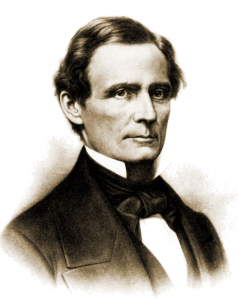
The U.S.S. Supply was one of the most active supply ships during this era and during the later Civil War. It’s exploits to the Middle East during the 1850’s made United States Naval history. Jefferson Davis arranged for the camels to be brought to an area near Victoria Texas and nearby Camp Verde and San Antonio. When the camels arrived the local populace was quite excited and amused.
The camels also created a stir among the horses and mules who picked up the camels unique scent. Both the horses and mules became agitated when the camels appeared. The situation was such that teamsters had to be told in advance when the camels were transported inland from the coast so they could make certain their horse and mule teams were out of the area.
Below are Three Interesting Trip Stops Regarding the Army Camel Corp
Hi Jolly and Quartzite Arizona
There’s a few unique sites you may want to add to your western trip planner that is part of this unique military camel experiment.
One of these unique sites is located in Quartzsite Arizona, about 80 miles north of Yuma Crossing and 129 miles west of Phoenix Arizona on the north side of Interstate 10.
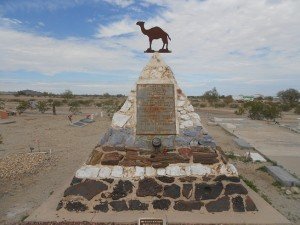
Today Quartzsite is very popular with winter RVer’s and there are many major gem and mineral shows scheduled during the months of January and February which bring in over one million visitors.
Quartzsite is also the final resting place of a man who was referred to as Hi Jolly, a man much involved with camels in Arizona. Hi Jolly was a name given to him by the military men he worked with. His real name was Hadji Ali and he was also later known as Philip Tedro. Born in the Ottoman Empire of Jordanian parentage Hadji Ali (pictured with Gertrude Serna below right) was the first ever camel driver hired by the U.S. Army. His job was to drive camels through the American Southwest during the army’s experiment using camels as beasts of burden.
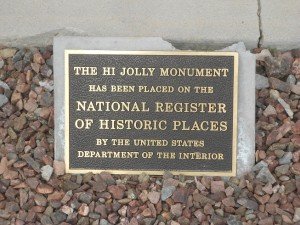
The story of Hi Jolly and his work with the U.S. Army during the mid 1800’s is an interesting tale of experiments and American exploration into a new region…the arid desert southwest…this new land taken over by the Americans as a result of the Mexican-American War.
Camel Treks and Historic Reenactments and Exhibits
The Texas Camel Corps guides camel treks through the Big Bend region of Texas. Camel trekking is like backpacking, only without having to carry anything. When you tire of riding, you can walk.
The Camel Barns which were built in 1855 can still be seen at the old Benicia Arsenal whose grounds now house the Benicia Historical Museum in Benicia California. Benicia is located northeast of San Francisco along Suisun Bay. Benicia is about a 35 mile drive from San Francisco.
See the Trips Into History articles on the links below…
The Southwest Expedition
The expedition in Texas was in-part conducted by a Major Henry C. Wayne who was quite familiar with the southwest having served with General Kearny in California during the Mexican War. Also recruited was Edward Fitzgerald Beale who was a former lieutenant in the Navy. Beale also recommended the appointment of one of his relatives, Navy lieutenant David Dixon Porter, to join the group. Porter went along with the U.S.S. Supply in it’s two voyages to find camels and drovers in the Mideast.
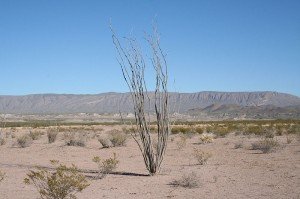
After the end of the Mexican-American War, the Army was needed to produce further surveys and construct additional wagon roads. Edward Beale was of big importance in this endeavor having ridden with Kit Carson throughout the southwest during the war.
The camels were brought to San Antonio on June 21, 1857 to be loaded. Beale set out across the south Texas plains and desert on June 25th and arrived in El Paso on July 27th. A stop was made at Fort Davis along the way. The journey passed through the dangerous Camanche lands, referred to as Comancheria, but without incident. When the caravan passed near to Mexico many of the locals came out to see these strange animals. On the trip up the Rio Grande to Albuquerque much the same occurred when the group passed through villages.
Performance of the Camels
Durring his travels with the caravan Beale made several interesting reports about the camels. He reported that the camels could travel continuously in a country where other barefooted beasts couldn’t last but a week. He further noted that the animals could live on anything and thrive. Beale said that on an extremely hot day the animals didn’t take a drink of water for over twenty-six hours.
Westward Toward California
When the group reached Albuquerque, Beale rode up to Santa Fe to make his report to the military authorities there. On August 13th the group headed out west to Ft Defiance where they were to meet a detachment under the command of a Colonel Loring.
From Fort Defiance the caravan followed the 35th parallel where their real work would start. That was a survey for a wagon road westward to the Colorado River. The expedition was not actually the very first to traverse this region since they did have a map with them drawn up during a 1853 expedition to survey a railroad route. This route today somewhat follows Interstate 40 through the northern part of Arizona.
The caravan continued westward from the Zuni Pueblo and did encounter some Pueblo Indians and Apaches along the way but all meetings were peaceful. Upon reaching the Colorado River, the crossing, while a bit difficult because the camels could not swim, was not as hard as predicted. The camels were roped together in gangs of five and were able to cross.
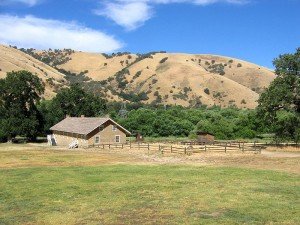
Moving further westward they split up and a group went to Los Angeles and another to Fort Tejon. The Mojave Desert crossing seemed to be uneventful since Beale only devoted a few sentences to it in his journal.
Beale left the camels at Ft Tejon and started a long journey eastward to Washington to make his formal report to Secretary of War Floyd. Eventually the camels in both California and Texas were costing the government a lot of money but nobody knew what to do next with the camels and Congress began to stop funding..
The Experiment Ends
Secretary Floyd and others were proponents of camel usage throughout the military, however the majority were not. A few military commanders in the west wanted to do other experiments with the camels of a purely military nature. Could these sturdy beasts possibly replace many of the horses? They could subsist on almost nothing so could this help the army in it’s consolidation of the southwest? After much debate and the start of the American Civil War the funding for the camels decreased and for all practical purposes the use of camels by the government and by private industry came to an end in the 1870’s.
Wild Camels Roam the Desert Southwest
In 1891, nine camels roaming on the western edge of Death Valley appeared before the eyes of two gold miners who thought they were seeing ghosts. This was decades after the camels were brought to North America. The miners, Shep Searcy and Charlie Fisher, were lying down at the time, trying to drink from a mud puddle, when Shep said: “Do you see what I think I see?” Fisher replied: “I don’t know what you see, Shep, but it looks like Barnum’s circus to me.” Shortly after that, the camels snorted, and ran away. When the miners reported their brief encounter to residents of a nearby town, people thought they were crazy. The camel experiment as long forgotten.
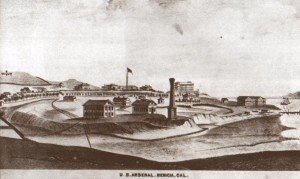
In October 1891, camels caused a cattle stampede outside Harrisburg, Arizona. Men stood around, amazed, not knowing what to do, when Harry Wharton, one of the original camel teamsters, approached to stroke one of the camels across the knees. The camel readily knelt. Harry then shot the animal dead. Two Mexicans stripped the carcass and sold the meat to an unsuspecting butcher.
In the 1890s, passengers on Southern Pacific trains reported seeing camels pacing the sands of Arizona Territory. In 1901, in western Arizona, a Southern Pacific train ran over and killed one of the animals.
(Article copyright 2014 Trips Into History)
